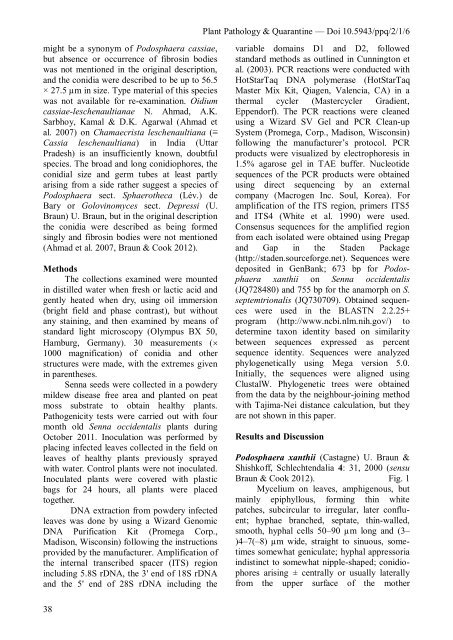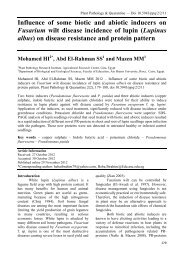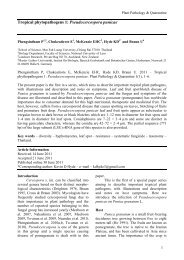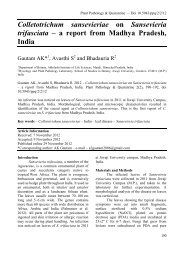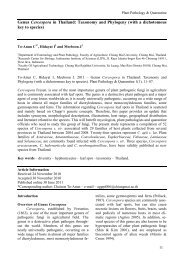Identity of powdery mildew on Senna in Mexico - Plant Pathology ...
Identity of powdery mildew on Senna in Mexico - Plant Pathology ...
Identity of powdery mildew on Senna in Mexico - Plant Pathology ...
You also want an ePaper? Increase the reach of your titles
YUMPU automatically turns print PDFs into web optimized ePapers that Google loves.
<strong>Plant</strong> <strong>Pathology</strong> & Quarant<strong>in</strong>e — Doi 10.5943/ppq/2/1/6<br />
might be a syn<strong>on</strong>ym <str<strong>on</strong>g>of</str<strong>on</strong>g> Podosphaera cassiae,<br />
but absence or occurrence <str<strong>on</strong>g>of</str<strong>on</strong>g> fibros<strong>in</strong> bodies<br />
was not menti<strong>on</strong>ed <strong>in</strong> the orig<strong>in</strong>al descripti<strong>on</strong>,<br />
and the c<strong>on</strong>idia were described to be up to 56.5<br />
× 27.5 µm <strong>in</strong> size. Type material <str<strong>on</strong>g>of</str<strong>on</strong>g> this species<br />
was not available for re-exam<strong>in</strong>ati<strong>on</strong>. Oidium<br />
cassiae-leschenaultianae N. Ahmad, A.K.<br />
Sarbhoy, Kamal & D.K. Agarwal (Ahmad et<br />
al. 2007) <strong>on</strong> Chamaecrista leschenaultiana (≡<br />
Cassia leschenaultiana) <strong>in</strong> India (Uttar<br />
Pradesh) is an <strong>in</strong>sufficiently known, doubtful<br />
species. The broad and l<strong>on</strong>g c<strong>on</strong>idiophores, the<br />
c<strong>on</strong>idial size and germ tubes at least partly<br />
aris<strong>in</strong>g from a side rather suggest a species <str<strong>on</strong>g>of</str<strong>on</strong>g><br />
Podosphaera sect. Sphaerotheca (Lév.) de<br />
Bary or Golov<strong>in</strong>omyces sect. Depressi (U.<br />
Braun) U. Braun, but <strong>in</strong> the orig<strong>in</strong>al descripti<strong>on</strong><br />
the c<strong>on</strong>idia were described as be<strong>in</strong>g formed<br />
s<strong>in</strong>gly and fibros<strong>in</strong> bodies were not menti<strong>on</strong>ed<br />
(Ahmad et al. 2007, Braun & Cook 2012).<br />
Methods<br />
The collecti<strong>on</strong>s exam<strong>in</strong>ed were mounted<br />
<strong>in</strong> distilled water when fresh or lactic acid and<br />
gently heated when dry, us<strong>in</strong>g oil immersi<strong>on</strong><br />
(bright field and phase c<strong>on</strong>trast), but without<br />
any sta<strong>in</strong><strong>in</strong>g, and then exam<strong>in</strong>ed by means <str<strong>on</strong>g>of</str<strong>on</strong>g><br />
standard light microscopy (Olympus BX 50,<br />
Hamburg, Germany). 30 measurements (<br />
1000 magnificati<strong>on</strong>) <str<strong>on</strong>g>of</str<strong>on</strong>g> c<strong>on</strong>idia and other<br />
structures were made, with the extremes given<br />
<strong>in</strong> parentheses.<br />
<strong>Senna</strong> seeds were collected <strong>in</strong> a <str<strong>on</strong>g>powdery</str<strong>on</strong>g><br />
<str<strong>on</strong>g>mildew</str<strong>on</strong>g> disease free area and planted <strong>on</strong> peat<br />
moss substrate to obta<strong>in</strong> healthy plants.<br />
Pathogenicity tests were carried out with four<br />
m<strong>on</strong>th old <strong>Senna</strong> occidentalis plants dur<strong>in</strong>g<br />
October 2011. Inoculati<strong>on</strong> was performed by<br />
plac<strong>in</strong>g <strong>in</strong>fected leaves collected <strong>in</strong> the field <strong>on</strong><br />
leaves <str<strong>on</strong>g>of</str<strong>on</strong>g> healthy plants previously sprayed<br />
with water. C<strong>on</strong>trol plants were not <strong>in</strong>oculated.<br />
Inoculated plants were covered with plastic<br />
bags for 24 hours, all plants were placed<br />
together.<br />
DNA extracti<strong>on</strong> from <str<strong>on</strong>g>powdery</str<strong>on</strong>g> <strong>in</strong>fected<br />
leaves was d<strong>on</strong>e by us<strong>in</strong>g a Wizard Genomic<br />
DNA Purificati<strong>on</strong> Kit (Promega Corp.,<br />
Madis<strong>on</strong>, Wisc<strong>on</strong>s<strong>in</strong>) follow<strong>in</strong>g the <strong>in</strong>structi<strong>on</strong>s<br />
provided by the manufacturer. Amplificati<strong>on</strong> <str<strong>on</strong>g>of</str<strong>on</strong>g><br />
the <strong>in</strong>ternal transcribed spacer (ITS) regi<strong>on</strong><br />
<strong>in</strong>clud<strong>in</strong>g 5.8S rDNA, the 3' end <str<strong>on</strong>g>of</str<strong>on</strong>g> 18S rDNA<br />
and the 5' end <str<strong>on</strong>g>of</str<strong>on</strong>g> 28S rDNA <strong>in</strong>clud<strong>in</strong>g the<br />
variable doma<strong>in</strong>s D1 and D2, followed<br />
standard methods as outl<strong>in</strong>ed <strong>in</strong> Cunn<strong>in</strong>gt<strong>on</strong> et<br />
al. (2003). PCR reacti<strong>on</strong>s were c<strong>on</strong>ducted with<br />
HotStarTaq DNA polymerase (HotStarTaq<br />
Master Mix Kit, Qiagen, Valencia, CA) <strong>in</strong> a<br />
thermal cycler (Mastercycler Gradient,<br />
Eppendorf). The PCR reacti<strong>on</strong>s were cleaned<br />
us<strong>in</strong>g a Wizard SV Gel and PCR Clean-up<br />
System (Promega, Corp., Madis<strong>on</strong>, Wisc<strong>on</strong>s<strong>in</strong>)<br />
follow<strong>in</strong>g the manufacturer’s protocol. PCR<br />
products were visualized by electrophoresis <strong>in</strong><br />
1.5% agarose gel <strong>in</strong> TAE buffer. Nucleotide<br />
sequences <str<strong>on</strong>g>of</str<strong>on</strong>g> the PCR products were obta<strong>in</strong>ed<br />
us<strong>in</strong>g direct sequenc<strong>in</strong>g by an external<br />
company (Macrogen Inc. Soul, Korea). For<br />
amplificati<strong>on</strong> <str<strong>on</strong>g>of</str<strong>on</strong>g> the ITS regi<strong>on</strong>, primers ITS5<br />
and ITS4 (White et al. 1990) were used.<br />
C<strong>on</strong>sensus sequences for the amplified regi<strong>on</strong><br />
from each isolated were obta<strong>in</strong>ed us<strong>in</strong>g Pregap<br />
and Gap <strong>in</strong> the Staden Package<br />
(http://staden.sourceforge.net). Sequences were<br />
deposited <strong>in</strong> GenBank; 673 bp for Podosphaera<br />
xanthii <strong>on</strong> <strong>Senna</strong> occidentalis<br />
(JQ728480) and 755 bp for the anamorph <strong>on</strong> S.<br />
septemtri<strong>on</strong>alis (JQ730709). Obta<strong>in</strong>ed sequences<br />
were used <strong>in</strong> the BLASTN 2.2.25+<br />
program (http://www.ncbi.nlm.nih.gov/) to<br />
determ<strong>in</strong>e tax<strong>on</strong> identity based <strong>on</strong> similarity<br />
between sequences expressed as percent<br />
sequence identity. Sequences were analyzed<br />
phylogenetically us<strong>in</strong>g Mega versi<strong>on</strong> 5.0.<br />
Initially, the sequences were aligned us<strong>in</strong>g<br />
ClustalW. Phylogenetic trees were obta<strong>in</strong>ed<br />
from the data by the neighbour-jo<strong>in</strong><strong>in</strong>g method<br />
with Tajima-Nei distance calculati<strong>on</strong>, but they<br />
are not shown <strong>in</strong> this paper.<br />
Results and Discussi<strong>on</strong><br />
Podosphaera xanthii (Castagne) U. Braun &<br />
Shishk<str<strong>on</strong>g>of</str<strong>on</strong>g>f, Schlechtendalia 4: 31, 2000 (sensu<br />
Braun & Cook 2012). Fig. 1<br />
Mycelium <strong>on</strong> leaves, amphigenous, but<br />
ma<strong>in</strong>ly epiphyllous, form<strong>in</strong>g th<strong>in</strong> white<br />
patches, subcircular to irregular, later c<strong>on</strong>fluent;<br />
hyphae branched, septate, th<strong>in</strong>-walled,<br />
smooth, hyphal cells 50–90 µm l<strong>on</strong>g and (3–<br />
)4–7(–8) µm wide, straight to s<strong>in</strong>uous, sometimes<br />
somewhat geniculate; hyphal appressoria<br />
<strong>in</strong>dist<strong>in</strong>ct to somewhat nipple-shaped; c<strong>on</strong>idiophores<br />
aris<strong>in</strong>g ± centrally or usually laterally<br />
from the upper surface <str<strong>on</strong>g>of</str<strong>on</strong>g> the mother<br />
38


